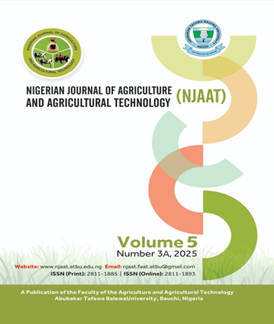GENETIC DIVERSITY STUDY OF SOME SEED AND MORPHOLOGICAL TRAITS OF LABLAB PURPUREUS USING CLUSTER, HEIRARCHICAL, AND PRINCIPAL COMPONENT ANALYSES
Keywords:
Lablab purpureus, Cluster, PCA, Hierarchical, HybridizationAbstract
The study evaluated genetic diversity of some Lablab purpureus accessions using multivariate analyses [Cluster, Hierarchical, and Principal Component Analyses (PCA)]. The plant materials were sourced from farmers’ farms in Ogun State, Nigeria, and the International Institute of Tropical Agriculture (IITA), Ibadan, Nigeria. 12 traits (6 seed and 6 morphological traits) were studied. The field plots were established at the Plant Biology Field of the Department of Biological Sciences, Tai Solarin University of Education, Ijagun, Nigeria, using a randomized complete block design (RCBD) with three replicates and a block size of 21m × 50m. Each plot was 1m × 2.5 m. Inter- and intra-row spacing was 1m and 0.25m, respectively, with ten (10) plants per plot. The principal component analysis explains a cumulative variance of 81.014% with four components (PC1 = 35.046%, PC2 = 22.359%, PC3 = 13.060%, and PC4 = 10.549%). The hierarchical analysis, presented with a dendogram, grouped the 28 accessions into seven linkage groups (clusters) with TSU-2 and TSU-44 being distinct and grouped into cluster 1 and cluster 7, respectively. In conclusion, a significant genetic diversity was observed among the understudied genotypes. Cluster and PCA effectively grouped the genotypes into 7 linkage groups based on the understudied traits, and the selected genotypes show great promise for future breeding of Lablab purpureus. Therefore, the use of genotypes from distinct clusters in this study can be used as parents in the hybridization of this crop. Replication of this study is recommended using molecular markers to complement morphological data.
Downloads
Downloads
Published
How to Cite
Issue
Section
License
Copyright (c) 2025 Nigerian Journal of Agriculture and Agricultural Technology

This work is licensed under a Creative Commons Attribution-NonCommercial-ShareAlike 4.0 International License.
This work is licensed under a CC Attribution-NonCommercial-ShareAlike 4.0



